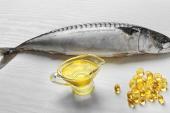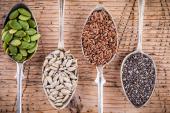Family History of CVD? Low PUFA Intake May Add to Risk
The observational study raises the tantalizing possibility that diet might help or harm with an otherwise nonmodifiable risk factor.

Failing to eat a diet rich in oily fish may exacerbate the risks of cardiovascular events already faced by people with a family history of heart disease, a new observational study suggests.
Researchers identified a significant interaction between the intake of polyunsaturated fatty acids (PUFAs) and a family history of cardiovascular disease. Although their data can’t explain the mechanism of interaction, they infer from their analyses that individuals with a genetic susceptibility to CVD might derive particular benefit from a diet rich in the n-3 PUFA eicosapentaenoic acid (EPA) and docosahexaenoic acid (DHA).
“We think it’s quite a safe message,” senior investigator Karin Leander, PhD, MPH (Karolinska Institute, Stockholm, Sweden), told TCTMD. “This is a large study combining worldwide data on fatty acids,” she continued, offering the caveat that it’s impossible make sweeping recommendations on the basis of a single study. At a minimum, however, consuming oily fish “seems like it would be beneficial for those with a family history of cardiovascular disease.”
Prevention guidelines recommend that physicians pay close attention to other risk factors, such as blood pressure, cholesterol, and smoking status, in patients with a family history. There are no special recommendations when it comes to following a particular diet in this higher-risk population, although the American Heart Association (AHA) suggests all people eat fish rich in unsaturated fats—salmon, trout, herring, anchovies, or mackerel, among others—at least twice per week.
Pradeep Natarajan, MD, MMSc (Massachusetts General Hospital, Boston), who wasn’t involved in the study, said that thus far there hasn’t been robust evidence to suggest an interaction between genetic susceptibility to CVD and diet in modifying future risk. However, they and others have done studies showing that genetic susceptibility to CVD based on a polygenic risk score and a unhealthy diet has an additive effect when it comes to CVD risk.
“While not tested prospectively, these studies suggest that [healthy] dietary patterns have similar relative benefits among those with high versus low polygenic risk,” he told TCTMD. “However, because those at high polygenic risk have greater risk, the additive benefit is greater.”
Randomized data from the PREDIMED study indicate that eating PUFA-rich foods is associated with a lower risk of CVD, he added. In this new study, low PUFA levels, likely related to low dietary intake, were also associated with increased CVD risk.
“Interestingly, and surprisingly, the authors found that those with a family history of cardiovascular disease—at least one first-degree relative with CVD, regardless of age—had an even greater relative risk from low PUFAs on CVD,” said Natarajan. “This implies an even greater overall absolute risk from low PUFAs driven by both the greater absolute risk from family history as well as greater relative risk of low PUFAs in this context.”
FORCE Consortium
The new study, which was led by Federica Laguzzi, PhD (Karolinska Institute) and published last week in Circulation, is another from the Fatty Acids and Outcomes Research Consortium (FORCE), which is a scientific group investigating the relationship between fatty acid intake and chronic disease. The purpose of this analysis, said Leander, was to determine if the risk of CVD in people with a family history would be heightened in those who ate a diet low in PUFAs.
The pooled population included data from 15 observational studies with more than 40,000 individuals (average age 62.7 years) in 10 countries. At baseline, men and women were followed for a median of 12.3 years, during which time there were 7,945 first CVD events.
Compared with individuals without a family history of disease and without low levels of EPA/DHA, defined below the 25th percentile, the people with low EPA/DHA and a family history of CVD had a 41% higher risk of fatal or nonfatal coronary heart disease or ischemic stroke (pooled RR 1.41; 95% CI 1.30-1.54). In contrast, those with a low EPA/DHA but not a family history of CVD had a 6% higher risk of cardiovascular events (pooled RR 1.06; 95% CI 0.98-1.14), while those with a family history of CVD but without low EPA/DHA had a 25% higher risk (pooled RR 1.25; 95% CI 1.16-1.33).
Investigators assessed the pooled risks of CVD events for double exposure (family history of CVD plus low EPA/DHA) levels on two scales. On the additive scale, where the combined effect of both exposures is either larger or smaller than the sum of the individual effects, the interaction was not statistically significant, said Leander. However, the interaction between low EPA/DHA and family history of CVD on the multiplicative scale, where the combined effect is larger or smaller than the product of the individual effects, was statistically significant.
To TCTMD, Leander said that because studying for interactions is so challenging in research, it’s recommended to test using different approaches.
“You can look at it on different scales and we found a significant interaction on one,” she said. “What was not significant was when we looked at the other model which investigates whether there is a synergistic interaction.” While that interaction was not statistically significant, the results point in the same direction, said Leander.
In contrast, there was no significant interaction on either scale for low levels of linoleic acid (LA) or alpha linolenic acid (ALA), which are primarily found in plants, seeds, and oils, and family history of CVD. Low intake of LA in those without a family history of CVD was associated with a 10% increased risk of CVD events, while low intake of ALA in those without a family history was associated with a trend toward higher risk.
One of the strengths of the new study, said Leander, is that researchers had access to biomarker data for PUFA intake measured in different lipid components as opposed to self-reported dietary intake questionnaires. While there are benefits of eating oily fish, Leander said this risk must be balanced with concerns about environmental pollutants. “One should follow the recommendations from [local] authorities in relation to what fish is recommended,” she said.
To TCTMD, Natarajan said what’s driving the interaction is unclear. He pointed out that a family history based on a CVD diagnosis in a first-degree relative is only significantly associated with premature CVD independent of risk factors if that relative died prematurely. In the present study, when researchers tested the interaction between low EPA/DHA and family history of premature CVD, the effect was attenuated and only borderline significant. The findings, he said, are “interesting” but will require further study to understand the interaction further.
Michael O’Riordan is the Managing Editor for TCTMD. He completed his undergraduate degrees at Queen’s University in Kingston, ON, and…
Read Full BioSources
Laguzzi F, Åkesson A, Marklund M, et al. Role of polyunsaturated fat in modifying cardiovascular risk associated with family history of cardiovascular disease: pooled de novo results from 15 observational studies. Circulation. 2023;Epub ahead of print.
Disclosures
- The authors report no relevant conflicts of interest.





Comments